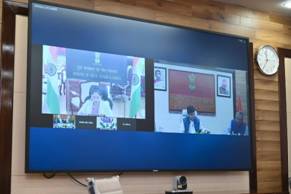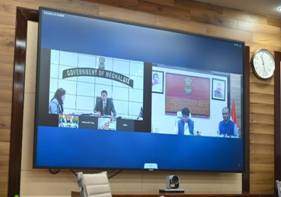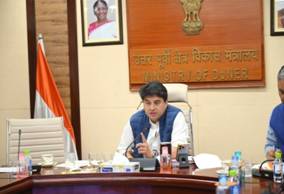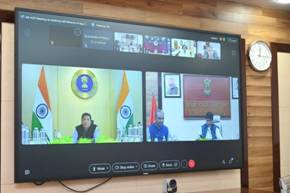Ministry of Development of North-East Region
Union Minister Shri Jyotiraditya M. Scindia participated in Two High Level Task Force Meetings on High-performance Sports Development across the Northeast and Self-reliance in Milk, Eggs, Fish and Meat.
60–40 model to be adopted in Sports with 60% Focus on Human Resource Development: Scindia
Unified Northeast Sports Strategy to Build India’s Next Generation of Sporting Champions: Scindia
Need for Integrated perspective for regional food systems strategy
Posted On:
19 NOV 2025 6:40PM by PIB Delhi
Union Minister of Communications and Development of North Eastern Region (DoNER), Shri Jyotiraditya M. Scindia, participated in two High-Level Task Force (HLTF) meetings on 19 November 2025, as part of the Government’s strategy to drive coordinated, participatory and impactful development across the North Eastern Region (NER). Earlier this year, the Ministry of DoNER constituted eight HLTFs each led by a Chief Minister of a North Eastern State, following the consensus of the 72nd NEC Plenary Session held in Agartala.
The meeting of HLTF on Sports, chaired by the Governor of Manipur, Shri. Ajay Kumar Bhalla, saw participation from Union Minister of State for Sports & Youth Affairs, Smt. Raksha Khadse; Sports Minister of Mizoram, Shri. Lalnghinglova Hmar; Sports Minister of Meghalaya, Shri. Shakliar Warjri ; Secretary, Ministry of DoNER and senior officials from the Government of Assam and the Sports Authority of India (SAI).
The meeting reinforced the “One Sport, One State” approach, with each participating State selecting a core discipline for comprehensive, end-to-end development. Building on this framework, Minister Scindia urged the participating States to prepare focused micro-proposals aligned with their chosen disciplines—Mizoram (Football), Manipur (Boxing & Weightlifting), Tripura (Judo), Meghalaya (Archery), Nagaland (Archery & Taekwondo), and Sikkim (Taekwondo). He underscored that these proposals must be developed jointly by State Sports Ministers and Secretaries, working closely with MoS Sports, Smt. Raksha Khadse and SAI DG to ensure alignment, ownership and sustainability.


Minister Scindia emphasised that the roadmap must leverage the region’s natural strengths by identifying cross-State commonalities such as Football, Weightlifting, Judo, Archery, and Taekwondo, and developing sport-specific strategies with clear ministerial accountability. The Minister highlighted that the proposal must adopt a “60–40 model” with 60% focus on human resource development, world-class coaching, talent scouting and technology-enabled training, and only 40% on physical infrastructure, noting that while infrastructure exists across the country, true sporting excellence requires advanced coaching ecosystems, athlete-centric methodologies and the integration of cutting-edge technology. Minister emphasised “From this strategy, we must develop a clear and focused proposal. There should be a 60–40 division, with 60 percent dedicated to the people who provide coaching and technology-supported guidance, and only 40 percent to infrastructure. While facilities exist across the country, the real priority is high-quality coaching and effective human intervention. This is essential because even as infrastructure expands, athletes often do not receive the advanced, standards-driven training they need to excel. The Ministry for Development of the North Eastern Region would be happy to provide its full support in advancing this vision.”
The Minister also called for each state to prepare a comprehensive sports calendar built bottom-up from pre-school, school and university levels to block-level tournaments supplemented by inter-state exposure, competitions and exchange programmes. He urged the adoption of a whole-of-government and whole-of-country approach to nurture the disciplines identified by the Northeast states, with the vision that at least one sport from the region should emerge as a national case study in the coming years. Scindia added that the strategy must balance a macro view of the eight North Eastern states with a micro, deep-dive approach into one selected discipline per State to drive excellence from the grassroots to elite levels.


The deliberations reflect the Government’s unwavering commitment to unlocking the Northeast’s sporting potential through coordinated planning, talent development, and targeted investment paving the way for the region to emerge as a powerhouse of high-performance sport and a significant contributor to the Viksit Bharat 2047 vision.
The meeting of HLTF on Self-reliance in Milk, Eggs, Fish and Meat was chaired by the Chief Minister of Arunachal Pradesh, Shri. Pema Khandu, and attended by Secretary, Ministry of DoNER and officials from Nagaland, the Department of Fisheries, and representatives from all eight North Eastern states.
The Task Force undertook a detailed demand–supply analysis for all eight States, creating the foundation for a truly composite framework that goes beyond a unidimensional approach. Discussions covered connectivity and logistics, infrastructure and value chains, human resources, breeding and productivity enhancement and avenues for expanding credit access and private investment. This integrated perspective is required for the region’s food systems strategy. The Minister emphasised, “Our aim is to build a connected, efficient and resilient food ecosystem for the Northeast that strengthens livelihoods, expands market access and ensures better nutrition for every citizen.”


To ensure rapid progress, the meeting resolved to begin interventions in two states for each product category—milk, eggs and poultry, meat and fisheries, to generate real-time learnings that can be scaled across the region, enabling sharper, evidence-driven expansion.
A clear implementation architecture was also outlined, with coordinated participation from Central Ministries, State Departments, and private stakeholders. Each intervention will be mapped to specific stages of the value chain so that responsibilities remain well-defined from origin to end consumer. Funding components for these pilots will similarly be structured with joint contributions from all three partners.
The discussions further underscored the need to view the Northeast as a single, integrated market. Better movement of surplus to deficit areas, identification of competitive strengths of each state, and stronger intra- and inter-state trade linkages will strengthen the region’s ability to operate as a cohesive food economy. Over time, this integrated market approach will catalyse efficient logistics, deeper market access, and broader economic opportunity.


Shri Scindia emphasized the importance of a bottom-up approach, drawing strength from the insights of each state while aligning them with national priorities and the expertise of the private sector. Concluding the session, he stated, “By strengthening production, upgrading value chains and improving logistics, we are laying the groundwork for a future where the Northeast’s food economy is self-reliant, market-ready and driven by shared prosperity”.
******
Prashant Sharma(AD)
(Release ID: 2191796)
Visitor Counter : 218